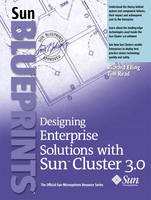
Designing Enterprise Solutions with Sun Cluster 3.0
Prentice Hall (Verlag)
978-0-13-008458-3 (ISBN)
- Titel gebraucht verfügbar
- Artikel merken
PLEASE PROVIDE
*Understand the theory behind system and component failures, their impact and subsequent cost to the Enterprise *Learn about the leading-edge technologies used inside the Sun Cluster 3.0 software *See how Sun Clusters enable Enterprises to deploy best practice cluster technology quickly and safely Designing Enterprise Solutions with Sun Cluster 3.0 is an introduction to architecting highly available systems with Sun servers, storage, and the Sun Cluster 3.0 software. Three recurring themes are used throughout the book: failures, synchronization, and arbitration. These themes occur throughout all levels of systems design. The first chapter deals with understanding these relationships and recognizing failure modes associated with synchronization and arbitration. The second and third chapters review the building blocks and describe the Sun Cluster 3.0 software environment in detail. The remaining chapters discuss management servers and provide hypothetical case studies in which enterprise solutions are designed using Sun technologies.Appendices provide a checklist for designing clustered solutions, additional information on Sun technologies used in many different types of clusters, guidelines for data center design best practices, and a brief description of some failure analysis tools used by Sun systems designers and architects.
RICHARD ELLING is the Chief Architect for Enterprise Engineering at Sun Microsystems in San Diego, California. Richard had been a field systems engineer at Sun for five years. He was the Sun Worldwide Field Systems Engineer of the Year in 1996. Prior to working at Sun, he was the Manager of Network Support for the College of Engineering at Auburn University, a design engineer for a startup microelectronics company, and worked for NASA doing electronic design and experiments integration for Space Shuttle missions. TIM READ is a Lead Consultant for the High End Systems Group in Sun UK's Joint Technology Organization. Since 1985 he has worked in the UK computer industry, joining Sun in 1990. He holds a B.Sc. in Physics with Astrophysics from Birmingham University. As part of his undergraduate studies, Tim studied clusters of suns; now he teaches and writes about Sun Clusters.
Preface.
Acknowledgements.
1. Cluster and Complex System Design Issues.
Business Reasons for Clustered Systems. Failures in Complex Systems. Data Synchronization. Arbitration Schemes. Data Caches. Timeouts. Failures in Clustered Systems. Summary.
2. Enterprise Cluster Computing Building Blocks.
Data Repositories and Infrastructure Services. Business Logic and Application Service. User Access Services: Web Farms. Compute Clusters. Technologies for Building Distributed Applications.
3. Sun Cluster 3.0 Architecture.
System Architecture. Kernel Infrastructure. System Features. Cluster Failures. Synchronization. Arbitration.
4. Management Server.
Design Goals. Services. Console Services. Sun Ray Server. Sun StorEdge SAN Surfer. Sun Explorer Data Collector. Sun Remote Service. Software Stack. Hardware Components. Network Configuration. Systems Management. Backup, Restore, and Recovery. Summary.
5. Case Study 1-File Server Cluster.
Firm Description. Design Goals. Cluster Software. Recommended Hardware Configuration. Summary.
6. Case Study 2-Database Cluster.
Company Description. Information Technology Organization. Design Goals. Business Case. Requirements. Design Priorities. Cluster Software. Recommended Hardware Configuration. Summary.
A. Sun Cluster 3.0 Design Checklists.
Business Case Considerations. Personnel Considerations. Top-Level Design Documentation. Environmental Design. Server Design. Shared Storage Design. Network Design. Software Environment Design. Security Considerations. Systems Management Requirements. Testing Requirements.
B. Sun Cluster Technology History and Perspective.
SPARCcluster PDB 1.x and SPARCcluster HA 1.x History. Sun Cluster 2.x. Sun Cluster 2.2 and 3.0 Feature Comparison.
C. Data Center Guidelines.
Hardware Platform Stability. Server Consolidation in a Common Rack. System Component Identification. AC/DC Power. System Cooling. Network Infrastructure. Security. System Installation and Configuration Documentation. Change Control Practices. Maintenance and Patch Strategy. Component Spares. New Release Upgrade Process. Support Agreement and Associated Response Time. Backup-and-Restore Testing. Cluster Recovery Procedures. Summary.
D. Tools.
Fault Tree Analysis, Reliability Block Diagram Analysis. Failure Modes and Effects Analysis. Event Tree Analysis.
Acronyms, Abbreviations, and Glossary.
Bibliography.
Index.
| Erscheint lt. Verlag | 18.12.2001 |
|---|---|
| Verlagsort | Upper Saddle River |
| Sprache | englisch |
| Maße | 179 x 235 mm |
| Gewicht | 599 g |
| Themenwelt | Informatik ► Office Programme ► Outlook |
| ISBN-10 | 0-13-008458-1 / 0130084581 |
| ISBN-13 | 978-0-13-008458-3 / 9780130084583 |
| Zustand | Neuware |
| Informationen gemäß Produktsicherheitsverordnung (GPSR) | |
| Haben Sie eine Frage zum Produkt? |
aus dem Bereich



